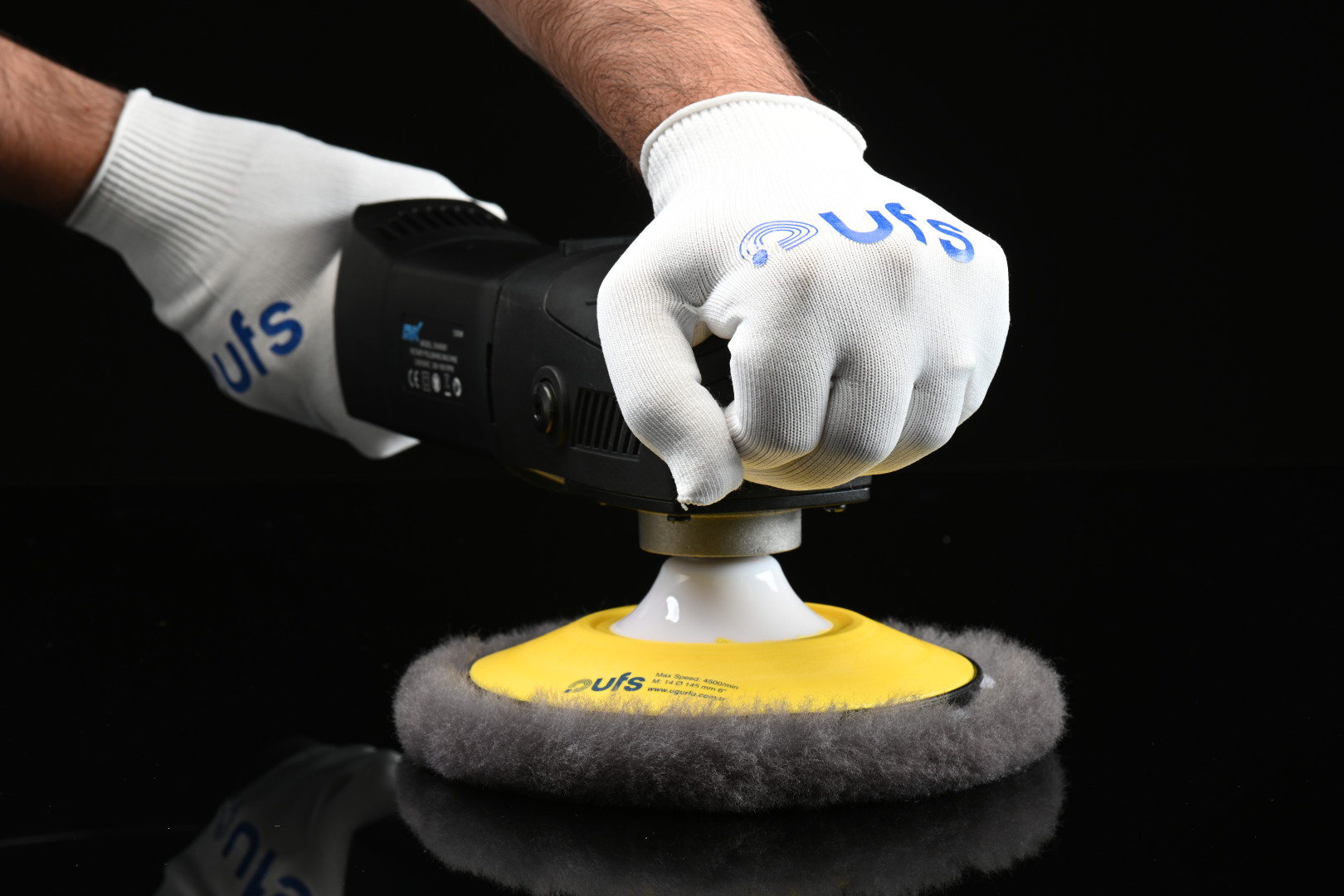
Polishing processes are critical operations conducted to make surfaces smoother, shinier, and more aesthetically pleasing. However, frequent mistakes during this process can lead to undesirable outcomes. Knowing and preventing these mistakes improves the quality of the process and extends the material's lifespan. Incorrect pad selection, insufficient or excessive pressure application, improper speed settings, inadequate surface preparation, and insufficient movement during the polishing process are some of the most common mistakes. Using the right techniques and avoiding these mistakes ensures more successful and effective polishing operations. We will delve into the details of these mistakes under each heading and explain how to prevent them.
Incorrect Polishing Pad Selection
The selection of a polishing pad plays a critical role in the success of the process. Using the wrong pad can lead to undesirable marks on the surface and prevent achieving the desired result. There are pads specifically designed for each surface type. For example, a lambswool polishing pad is ideal for soft and delicate surfaces. Choosing the wrong pad can reduce the efficiency of the process and result in unwanted outcomes such as scratches and wear on the surface. Additionally, incorrect pad selection can prolong the process and increase energy consumption. Selecting the correct pad shortens the process time and helps achieve a brighter and smoother surface finish. Using incorrect pads can damage the surface's structure and shorten the material's lifespan. Therefore, selecting the appropriate pad for each surface type enhances the quality and efficiency of the process. When selecting a polishing pad, it's important to consider the type of surface and the purpose of the process. Additionally, the quality of the pad should also be considered, and reliable brands should be preferred.
Using Inappropriate Materials
The use of appropriate materials in polishing processes is a crucial factor that directly affects the quality of the process. Using inappropriate materials can lead to scratches, wear, and unwanted texture changes on the surface. There are materials specifically produced for each surface type, and using these materials correctly enhances the success of the process. Choosing the wrong material can cause irreversible damage to the surface. For instance, soft materials should be preferred for delicate surfaces. Hard materials can leave unwanted scratches and marks on sensitive surfaces.
Incorrect Pad Selection Based on Surface Type
Selecting the appropriate pad for the surface type is a critical factor that determines the quality and effectiveness of the polishing process. Incorrect pad selection can cause unwanted marks and damage to the surface. There are pads specifically designed for each surface type, and proper use of these pads increases the success of the process. For example, hard pads should be used for hard surfaces, and soft pads for soft surfaces. Using hard pads on soft surfaces can lead to scratches and wear. Additionally, pads not suitable for the surface type can prolong the process and increase energy consumption.
Applying Insufficient or Excessive Pressure
The pressure applied during polishing processes directly affects the quality of the operation. Applying insufficient or excessive pressure can lead to undesirable outcomes on the surface.
Consequences of Insufficient Pressure
Insufficient pressure results in an ineffective polishing process. In this case, the desired brightness and smoothness on the surface cannot be achieved. Issues such as prolonged process duration and inadequate results may arise. Insufficient pressure prevents the pad from fully contacting the surface, leading to irregularities and roughness remaining on the surface. Additionally, when insufficient pressure is applied, polishing compounds are not evenly spread over the surface, reducing its brightness. Therefore, applying the correct pressure ensures the surface is polished to the desired quality and shortens the process time.
Damages of Excessive Pressure
Excessive pressure can cause severe damage to the surface. Problems such as overheating of the surface, damage to the pad, and the formation of burn marks may occur. Excessive pressure leads to scratches and wear on the surface. Additionally, it shortens the lifespan of the pad and requires more frequent replacement. This situation increases costs and reduces the efficiency of the process. Using the correct pressure settings ensures the surface is smooth and shiny and extends the material's lifespan. Moreover, applying pressure suitable for the surface's structure enhances the quality of the process and prevents undesirable outcomes.
Using Incorrect Speed Settings
The speed settings used in polishing processes directly affect the quality and efficiency of the operation. Using incorrect speed settings can lead to undesirable outcomes on the surface. Incorrect speed settings can cause problems such as overheating, burn marks, and irregularities on the surface.
Effects of Low Speed
Polishing at low speed prolongs the process and makes it difficult to achieve the desired brightness. A slowly moving pad may not contact the surface adequately, and the polishing compound may not be evenly distributed on the surface. In this case, irregularities and roughness may remain on the surface. Additionally, working at low speed can increase energy consumption and reduce the efficiency of the process. To ensure the surface shines uniformly, it is important to use speed settings suitable for the surface type.
Problems Caused by High Speed
Polishing at high speed can cause excessive heating on the surface and damage the material. High speed can cause the pad to apply too much pressure on the surface, resulting in burn marks. Moreover, working at high speed can lead to scratches and wear on the surface. The lifespan of the pad may also be shortened at high speeds, requiring more frequent replacement. Using speed settings appropriate for the surface type improves the quality of the process and ensures the surface is smoother and shinier. Correct speed settings prevent damage to the surface and increase the efficiency of the polishing process.
Inadequate Surface Preparation
Proper preparation of the surface before polishing is another crucial factor that determines the quality of the process. Adequate preparation of the surface makes the process more effective and prevents undesirable outcomes.
Dirty or Dusty Surfaces
Dirty or dusty surfaces reduce the efficiency of the polishing process. Dust and dirt prevent the pad from making proper contact with the surface, preventing the desired brightness from being achieved. Cleaning the surface enhances the quality of the process. Polishing on a dirty surface can clog the pad and cause scratches on the surface. Additionally, dust and dirt particles can leave unwanted marks on the surface. Therefore, the surface should be cleaned and dusted before the polishing process. Cleaning the surface increases the efficiency of the process and makes the surface smoother.
Not Removing Old Residues on the Surface
Leaving old residues on the surface reduces the efficiency of the new polishing process. Old residues reduce the effectiveness of the new process and can cause irregularities on the surface. Residues on the surface prevent the pad from making proper contact with the surface, preventing the desired brightness from being achieved. Therefore, it is important to completely clean the surface and remove old residues. Cleaning the surface makes the process more effective and ensures the surface is smoother and shinier. Failure to remove old residues can leave unwanted marks and irregularities on the surface. Therefore, the surface should be thoroughly cleaned before the polishing process. Cleaning the surface increases the efficiency of the process and makes the surface longer-lasting.
Insufficient Movement During the Polishing Process
Insufficient movement on the surface during the polishing process reduces the efficiency of the process and leads to undesirable outcomes on the surface. Ensuring equal distribution on the surface enhances the quality of the process.
Staying on the Same Spot for Too Long
Staying on the same spot for too long causes the surface to overheat and get damaged. This situation can lead to burn marks and scratches on the surface. Constantly moving the pad during the polishing process ensures that the surface shines homogeneously. Staying on the same spot for too long causes the pad to apply too much pressure on the surface, leaving unwanted marks. Additionally, excessive heating of the surface can deteriorate the material's structure and shorten its lifespan. Therefore, it is important to constantly move the pad during the polishing process and ensure even distribution on the surface.
Not Ensuring Equal Distribution on the Surface
Not ensuring equal distribution on the surface reduces the efficiency of the process and can cause irregularities on the surface. Ensuring equal distribution of the pad on the surface during the polishing process ensures that every point on the surface shines with the same quality. Failure to ensure equal distribution can create differences in brightness and smoothness on the surface. This situation reduces the quality of the process and negatively affects the aesthetic appearance of the surface. Additionally, failure to ensure equal distribution on the surface can cause excessive wear in some areas. Moving the pad evenly across the surface during the polishing process improves the quality of the process and ensures the surface is smoother and shinier. Ensuring equal distribution on the surface increases the efficiency of the process and extends the surface's lifespan.
How to Prevent Mistakes in Polishing Processes?
Preventing frequent mistakes in polishing processes increases the quality and efficiency of the process. Using the correct techniques, selecting the right equipment and materials, and knowing the factors to be considered during the process ensure the successful completion of polishing processes. Here are some key points to prevent these mistakes:
- Using the appropriate pad and material for each surface type increases the quality of the process. For example, a lambswool polishing pad is ideal for soft and delicate surfaces. Choosing the wrong pad can cause scratches and wear on the surface.
- Applying the correct pressure during the polishing process prevents damage to the surface. Insufficient pressure makes the process ineffective, while excessive pressure leads to scratches and burn marks on the surface. Adjusting the pressure according to the surface's structure is important.
- Using appropriate speed settings during the polishing process ensures the surface is smoother and shinier. Low speed prolongs the process, while high speed can cause overheating and damage to the surface. Using speed settings suitable for the surface type improves the quality of the process.
- Cleaning and dusting the surface before the polishing process increases the efficiency of the process. Dirty or dusty surfaces prevent the pad from making proper contact with the surface, preventing the desired brightness from being achieved. Removing old residues ensures the process is effective.
- Constantly moving the pad during the polishing process prevents overheating and damage to the surface. Staying on the same spot for too long can cause burn marks and scratches on the surface. Ensuring equal distribution on the surface improves the quality of the process.
- Using quality equipment and materials in polishing processes increases the efficiency and quality of the process. Products from reliable brands should be preferred.
- Having trained and experienced personnel conduct polishing processes is an important factor in preventing mistakes. Knowing and applying the correct techniques ensures the process's success.
- Regular maintenance and inspection of polishing equipment ensure efficient operation and prevent potential malfunctions. Regular replacement and cleaning of pads improve the quality of the process.
Paying attention to these points in polishing processes ensures a more successful and effective operation. Preventing mistakes ensures the surface is smoother and shinier while also extending the material's lifespan.

.JPG)
.JPG)

